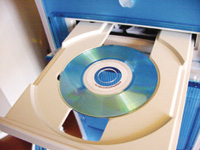Building A Portfolio
In The Digital Age
You know how it goes: The Art Director says, "I know you can photograph right-handed baseball players, but can you photograph left-handed ones?" An unfortunate reality of the photography business is that you have to constantly prove to potential buyers that you can produce--or have already made--images just like the one they need right now. Your key marketing tool during this aspect of the sales process is the portfolio. Yet, traditional laminated print portfolios can be so expensive that many photographers find it difficult to create additional ones for specific market segments. Whether you use a laminated portfolio of prints and tear sheets or a tray of slides, you'll need several of them and they must constantly be updated. All of which adds up to additional time and expense. Recently, my friend Barry Staver who is a People magazine photographer asked me about a fast, easy way to produce a portfolio that he could overnight to potential clients. In this digital age he was, understandably, looking for a digital solution to his dilemma. One of the biggest problems with using any form of purely digital portfolio is you cannot even assume your potential client has the same kind of computer system that you have. With a traditional print portfolio, all a client has to do is open the box you shipped it in and look. There is nothing to plug-in, insert, or turn on. No batteries are required. They can review your images while on a train coming in to work or during downtime while waiting for a meeting to start. With a digital portfolio, you have to ask: How big is their monitor, what is its resolution, and how many colors does their video card support? What about the amount of system memory? Take My Portfolio, Please
|
|||
|
Don't get me wrong; I'm not opposed to creating a digital portfolio. Effective marketing has always included a mix of media and you have to select a combination of promotional tools that will work for your specific demographics. In a perfect world, one method will work for all of your potential clients, but out here in the real world, you'll need both digital and print portfolios. Customized Portfolios For his 35mm and 120 negatives and transparencies, Staver uses Photo CD as an image acquisition method. He tweaks each image's color, brightness, and contrast and occasionally performs subtle manipulations with a Power Macintosh G4 and Adobe Photoshop software. Images are sized to fit the album pages and, depending on the portfolio, Staver places a single image on a page. This is not a hard-and-fast rule for him and shouldn't be for you either. Using Quark XPress he combines as many images as will fit on a 13x19 sheet and gang prints them with an Epson Stylus Pro 5000 ink jet printer. After the sheet of images is printed he trims them, leaving a thin white boarder around each photograph to separate the images from the black album page. Prints are attached to the inserts using double-sided adhesive tape. When he's finished, he has a 14-page portfolio with his studio name imprinted in gold that cost $40--less than the cost of a single laminated custom lab print. Other binders are available from companies such as Icon Distribution, and I plan to convert my own print portfolio to their inexpensive, but classy looking Turbo Folio. |
|||
What A Web We Weave First, a web site is less expensive to change and update than traditional, non-electronic media. Four-color printing is expensive and if you order 5000 brochures it may take some time to distribute all of them. By the time you're down to brochure number 4989 you've probably created many better photographs than the ones pictured on the brochure. Changing images on a web site is a matter of scanning new ones (or having someone do it for you) and posting them on your homepage. Adobe Photoshop's File>Save for web command makes creating images that look good and display quickly easy for even a web newbie. Second, you only need to have one web site. There's no need to have 5000 brochures printed or to have duplicate portfolios made so you can ship the images to several different places at the same time. A single web site will be accessible to many thousands of photo buyers around the country--even around the world. Before you construct a web site, you should establish the parameters. Start by asking what you hope to accomplish and how you intend to accomplish it. Without clear goals, a web site will be just as much a waste of time and effort as a brochure that's full of pretty pictures but doesn't ask for a sale. All Digital All The Time MGI's PhotoSuite Mobile Edition software lets users store, view, and share photographic and video files using Palm OS handheld devices. The package includes a Windows-based desktop application called PhotoSuite Mobile Organizer that lets you enhance image files before transferring them to their PDA (Personal Data Assistant) software PhotoSuite Mobile Organizer. This package supports graphic image file formats including JPEG, PNG, BMP, GIF, as well as AVI, WMV, and MOV. Since the program supports MOV files, you can also display portfolios created with Voyager's PhotoFolio software. PhotoSuite Mobile Organizer also lets you "beam" photos and video clips to other handheld devices, even transferring color images to a gray scale PDA. The retail price of MGI PhotoSuite Mobile Edition is $24.95 and you can download a 14-day trial version at www.photosuite.com/palm. |
|||
Edit, Edit Again, Then Edit
Some More Portfolio On A Disc CD Biz Card (www.bizcardcdrom.com/downloads.htm) Manufacturers/Distributors |



















































